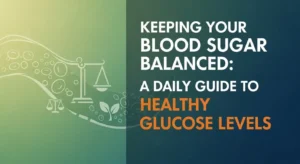Diabetes is a serious health condition that affects how your body uses sugar. While many people know diabetes can impact your heart, kidneys, and nerves, did you know it can also have a big effect on your eyes? In fact, eye problems are some of the earliest signs that diabetes might be developing or isn't well-controlled. Catching these “early stage diabetes eyes symptoms” quickly is super important because it can help save your vision!

This article will walk you through the common eye symptoms linked to early diabetes. We'll explain why they happen and what you can do about them. By understanding these signs, you can be proactive about your health and get the right help when you need it. Let's dive in!
Early Diabetes Eye Symptom Checker
Select any eye symptoms you've experienced recently. This tool can help you decide if you should talk to your doctor about potential **early stage diabetes eyes symptoms**.
Vision Changes
Visual Disturbances
Eye Discomfort
Remember, this is not a diagnosis. Only a doctor can tell you if you have diabetes or an eye condition.
This tool is for informational purposes only and should not replace professional medical advice. Always consult with a healthcare provider for any health concerns.
Key Takeaways
- Blurred Vision is a Red Flag: Often, one of the first early stage diabetes eyes symptoms is blurry or fluctuating vision, which happens due to changes in blood sugar levels affecting the eye's lens.
- Don't Ignore Floaters: Seeing new "floaters" or dark spots in your vision can signal early damage to the tiny blood vessels in your retina, a part of your eye.
- Light Sensitivity & Eye Pain: Increased sensitivity to light or a feeling of pressure/pain in the eyes can also be subtle indicators of eye strain or more serious issues related to diabetes.
- Regular Eye Exams are Crucial: Even if you don't have symptoms, annual comprehensive eye exams are vital for detecting early stage diabetes eyes symptoms before they become serious.
- Manage Blood Sugar: The best way to protect your eyes from diabetes-related damage is to keep your blood sugar levels stable through diet, exercise, and medication as advised by your doctor.
Understanding Diabetes and Your Eyes
Before we talk about symptoms, let's quickly understand why diabetes affects your eyes. When you have diabetes, your body either doesn't make enough insulin or can't use insulin properly. Insulin is like a key that unlocks your cells to let sugar (glucose) in for energy. Without enough working insulin, sugar builds up in your blood.
This high blood sugar can damage tiny blood vessels all over your body, including those in your eyes. The most critical part of your eye affected is the retina. The retina is the light-sensitive layer at the back of your eye that sends images to your brain. Think of it like the film in a camera! When these tiny blood vessels in the retina get damaged, it's called diabetic retinopathy, and it's the leading cause of blindness in adults with diabetes.
The good news? If you catch the signs of this damage early, there's a lot that can be done to protect your vision. That's why knowing the early stage diabetes eyes symptoms is so important.

Common Early Stage Diabetes Eye Symptoms
It's important to remember that some people with early diabetic eye problems might not have any symptoms at all. This is why regular eye check-ups are so vital. However, if you notice any of the following, it's a good idea to talk to your doctor right away.
1. Blurred or Fluctuating Vision 🌫️
This is often one of the very first signs people notice. Your vision might become blurry, or it might seem clear one day and blurry the next. This isn't usually due to permanent damage at first. Instead, it's often caused by high blood sugar levels changing the shape of the lens in your eye.
Why it happens: When blood sugar levels go up and down, fluid can shift into and out of the lens of your eye. This changes the lens's shape, making it harder for your eye to focus clearly. It's like trying to look through a camera lens that keeps changing its focus!
What to look for:
- Difficulty reading fine print.
- Trouble seeing objects clearly, both near and far.
- Your vision seems to change throughout the day.
- You might notice your glasses or contact lenses don't seem to work as well anymore.
"Many people don't realize their blurry vision could be a sign of diabetes. It's often dismissed as just needing new glasses, but it's a symptom that definitely warrants a closer look." — Dr. Emily Carter, Ophthalmologist

2. Seeing Floaters or Dark Spots
Have you ever seen little specks, threads, or cobweb-like shapes drifting across your vision? These are called "floaters." While occasional floaters can be normal, especially as you get older, a sudden increase in their number or size, or seeing them accompanied by flashes of light, could be a red flag.
Why it happens: In early diabetic retinopathy, the tiny blood vessels in your retina can start to leak fluid or blood. These leaks, or even bits of scar tissue that form, can appear as floaters in your vision. It's a sign that the delicate blood vessels are under stress.
What to look for:
- New, persistent spots or strings that drift when you move your eyes.
- Shapes that seem to "float" away when you try to look directly at them.
- A sudden shower of new floaters.
- Floaters accompanied by flashes of light. This could signal a more serious issue like a retinal detachment, which needs immediate medical attention.
3. Increased Light Sensitivity
Do bright lights suddenly bother your eyes more than they used to? Do you find yourself squinting or needing to wear sunglasses indoors? This could be a symptom.
Why it happens: Diabetes can affect the health of your eye's various structures, including the iris (the colored part that controls how much light enters your eye) and the retina. Damage to the retina can make it more sensitive to light, causing discomfort or pain in bright environments.
What to look for:
- Discomfort or pain when exposed to normal indoor lighting.
- Difficulty adjusting to bright sunlight.
- Frequent squinting.
4. Eye Pain or Pressure
While less common as an early symptom directly linked to diabetic retinopathy, persistent eye pain or a feeling of pressure can sometimes be associated with diabetic eye conditions like glaucoma, which can occur more frequently in people with diabetes.
Why it happens: High blood sugar can damage the eye's drainage system, leading to a buildup of fluid and increased pressure inside the eye. This is a condition called glaucoma, which can damage the optic nerve. Also, general eye strain from blurry vision can cause discomfort.
What to look for:
- Aching or throbbing pain in or around the eye.
- A feeling of pressure behind the eye.
- Headaches associated with eye discomfort.
5. Difficulty Seeing at Night
Struggling to see clearly in dim light or at night can also be an early indicator.
Why it happens: Damage to the retina, particularly the cells responsible for low-light vision (rods), can make it harder for your eyes to adapt to darkness. This can make driving at night or navigating in dimly lit rooms challenging.
What to look for:
- Trouble seeing road signs or pedestrians while driving at night.
- Difficulty seeing objects in poorly lit rooms.
- Needing more light than usual for tasks.
6. Vision Loss or Blind Spots
While often a sign of more advanced diabetic retinopathy, sometimes a small area of vision loss or a blind spot can appear in the earlier stages, especially if there's bleeding in the eye.
Why it happens: If a blood vessel in the retina leaks significantly or new, abnormal blood vessels grow and bleed (a more advanced stage called proliferative diabetic retinopathy), it can block your vision, creating dark or empty areas.
What to look for:
- A dark or empty spot in your central or peripheral vision that doesn't go away.
- A sudden, significant decrease in vision in one or both eyes.

Why Early Detection Matters So Much
Detecting these early stage diabetes eyes symptoms is not just about getting new glasses; it's about protecting your long-term vision. Here's why:
- Preventing Permanent Damage: Many diabetic eye conditions, if caught early, can be managed or treated to prevent severe vision loss or blindness. Once significant damage occurs, it's much harder to reverse.
- Controlling Diabetes: Eye symptoms can be a wake-up call that your blood sugar levels are not well-controlled. Addressing these symptoms means also addressing your overall diabetes management, which benefits your entire body.
- Better Treatment Outcomes: Treatments for diabetic eye disease, such as laser therapy or injections, are much more effective when applied in the early stages of the disease.
What to Do if You Notice Symptoms
If you experience any of the early stage diabetes eyes symptoms discussed, it's crucial to act promptly.
- See Your Doctor: Make an appointment with your primary care doctor. Tell them about your eye symptoms and ask about getting tested for diabetes if you haven't been diagnosed already.
- Visit an Eye Specialist: Your doctor will likely recommend you see an ophthalmologist (an eye doctor who specializes in medical and surgical eye care). They can perform a comprehensive dilated eye exam, which is the best way to check for diabetic eye disease.
- During a comprehensive dilated eye exam:
- The doctor will put drops in your eyes to make your pupils wider. This allows them to see the back of your eye, including your retina and optic nerve, more clearly.
- They will look for signs of damaged blood vessels, swelling, fluid leaks, or new abnormal blood vessel growth.
- During a comprehensive dilated eye exam:
- Manage Your Diabetes: If you are diagnosed with diabetes, or if your existing diabetes is not well-controlled, working closely with your healthcare team is key. This includes:
- Controlling Blood Sugar: This is the most important step! Keeping your blood sugar levels as close to normal as possible can slow down or prevent eye damage.
- Managing Blood Pressure and Cholesterol: High blood pressure and high cholesterol can also worsen diabetic eye disease.
- Healthy Lifestyle: Eating a balanced diet, getting regular exercise, and maintaining a healthy weight are vital. For some insights into weight management, you might find information on 3-day fast weight loss or general Liv Pure reviews helpful in your journey to better health.
- Medication: Take all prescribed medications as directed by your doctor.
Beyond the Eyes: Other Diabetes Connections
While we're focusing on eye symptoms, it's worth remembering that diabetes is a systemic disease, meaning it affects your whole body. For instance, men with diabetes might also experience other health challenges, including prostate issues. If you're interested in learning more about managing prostate health, you can explore resources like the most effective prostate supplements reviewed for 2025, information on Prostavive for tackling prostate problems, or a general guide to prostate supplements. These links highlight the importance of holistic health management.

Prevention is Key
The best approach to protecting your vision from diabetes is prevention. Even if you don't have diabetes, or if you're pre-diabetic, adopting healthy habits can significantly reduce your risk.
Here's a quick checklist for eye health:
| Action Item | Why It Helps Your Eyes |
|---|---|
| Regular Eye Exams | Catches problems early, often before symptoms appear. |
| Control Blood Sugar | Prevents damage to tiny blood vessels in the retina. |
| Manage Blood Pressure & Cholesterol | Reduces additional stress on blood vessels. |
| Eat a Healthy Diet | Provides essential nutrients for eye health and helps control blood sugar. |
| Stay Active | Improves overall health and helps regulate blood sugar. |
| Quit Smoking | Smoking significantly increases the risk of diabetic eye disease and other complications. |
| Limit Alcohol | Excessive alcohol can impact blood sugar control. |
Remember, your eyes are precious. Don't wait for severe symptoms to appear. Be proactive, listen to your body, and get regular check-ups.
Conclusion
Recognizing early stage diabetes eyes symptoms is a powerful step in protecting your vision and overall health. Blurred vision, floaters, light sensitivity, and even subtle changes in night vision can be important clues. These symptoms are your body's way of telling you that something might be off with your blood sugar.
If you experience any of these signs, don't hesitate to consult your doctor and an eye specialist. Early detection and consistent management of your blood sugar, blood pressure, and cholesterol are the best ways to keep your eyes healthy for years to come. Your vision is worth protecting!








